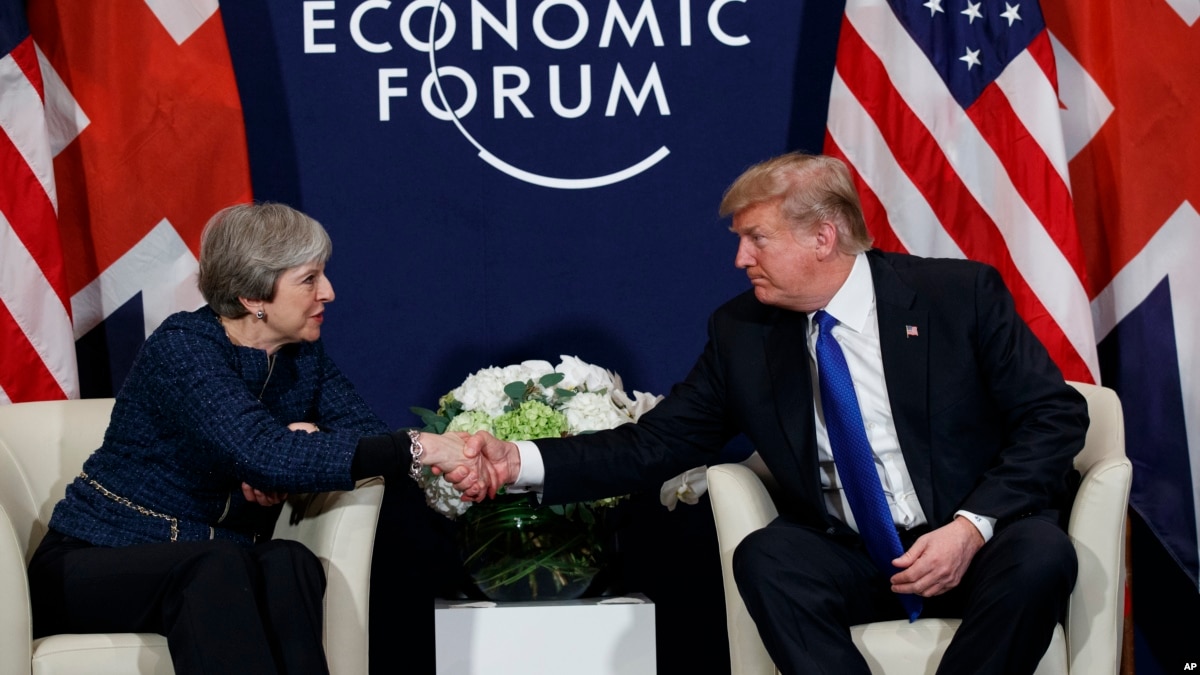
Last year it was tight-gripped hand-wrestling between Donald Trump and France’s Emmanuel Macron that attracted media attention. Neither male leader seemed to want to be the first to let go during their first face-to-face meeting in July, resulting in what was dubbed the “never-ending handshake.”
On Thursday, it was the U.S. leader’s prolonged Davos handshake with Britain’s Theresa May that excited fevered media speculation with the British press seeing it as an expression of how the recently troubled ‘special relationship’ between Britain and the United States is back on track.
The Trump-May handshake was analyzed by the European media almost as much as the grab-and-pull power pump between Trump and Macron that lasted 30-seconds and came across to some as a tussle between Alpha males. The warm handshake between the U.S. and British leaders, according to commentators, reinforced the friendly words between the two, who talked about how the two countries are joined at the hip and even the shoulder.
Tabloid newspapers in London plastered photographs of the handshake on their front-pages.
The Daily Express blazoned the question: “Has May ‘tamed’ Trump?” And the newspaper quoted a body-language expert who commented that Trump arrived for the World Economic Summit in Davos, Switzerland, “like a posturing prizefighter entering the ring but during his press conference with May he stopped showboating and looked truly respectful.”
She added that “he used direct eye contact” when he remarked at the news conference to May “rather romantically that ‘I will always be there for you - you know that' and he produced the most normal handshake of his presidency so far.”
Britain’s Sky News also turned to a body-language expert to interpret the first meeting between the two leaders since their public clash over the president’s re-tweeting in November of a British far-right anti-Muslim campaigner, which earned a rebuke from May.
“A love-in,” pronounced the broadcaster’s satisfied Cordelia Lynch.
Handshake analysis
Why is a handshake so important? Transatlantic ties have taken on even greater importance for Britain as it struggles to shape a post-Brexit future. A trade deal with the United States could help offset the costs of leaving the European Union, Britain’s biggest trading partner, and May’s aides say a stronger alliance with America is critical to making a success of Brexit.
Hence the relief of both British officials and the country’s media at the public displays of affection between May and Trump in Davos only weeks after the U.S. leader canceled a planned trip to London next month for the official opening of a new U.S. embassy building in the British capital.
That cancellation followed a series of clashes between the pair including over Iran and intelligence leaks. The handshake was seized by the British as a public prize — an affirmation of sincerity.
But should a handshake be laden with so much importance?
Body-language has long been seen as an important element in diplomacy. “Communication is to diplomacy as blood is to the human body,” academics Christer Jönsson and Martin Hall noted in a study emphasizing that non-verbal language is as important as what is spoken during diplomatic encounters.
Body language
In 2014, USA Today revealed that the Pentagon had established a research team to study the body movements of Russian President Vladimir Putin and other world leaders in order to better understand them, assess their sincerity and to predict their possible future actions.
According to an official with the Office of Net Assessment (ONA), “the goal is to learn about the physical movements of national leaders and determine if these can be used to gain insight about a leaders' attitudes, mindset, etc. ONA does not make policy recommendations, so we cannot assert with any certainty how the studies have been used by policy-makers.”
France’s Macron certainly vested a lot in his handshake with Trump, admitting on French television that he viewed it as a “moment of truth.”
European officials and the continent’s media appear obsessed by Trump’s body language — more than with any other recent U.S. leader.
Some commentators say that’s because Trump’s body language appears to be more distinct and unpredictable than his predecessors.’ Others suggest it is because they are still trying to take the measure of a politician, who has upended U.S. politics and foreign policy and defied expectations and norms since he entered the race for the White House and pulled off an upset win. His governing style has been as unusual as his campaigning tactics.
A former Trump aide, Sam Nunberg, argued last year that in fact Trump invites the speculation and knows what he’s doing with body language. “I just think the president is very cognizant of the optics of what it looks like at these multi-lateral meetings with world leaders,” he told the Huffington Post website. “There is nobody who is a better showman,” he added.
Read More Trump Proves That in Diplomacy, Body Language as Revealing as Words : http://ift.tt/2DMXglI/cloudfront-us-east-1.images.arcpublishing.com/bostonglobe/VNG7YMZTRWJ5WBFTJ5NVETPCQI.jpg)
No comments:
Post a Comment